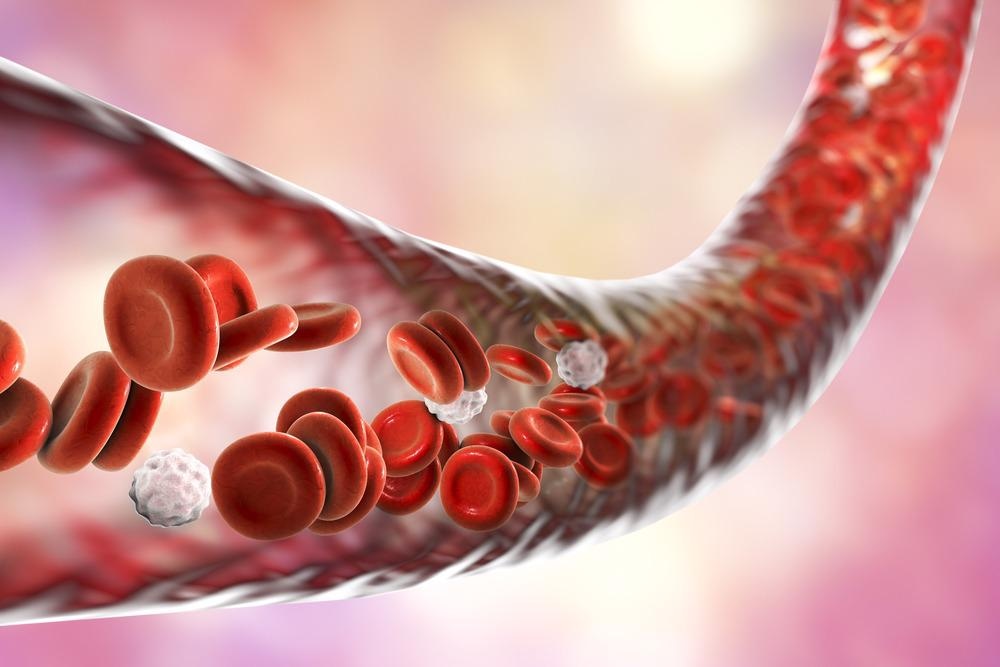Scientists have recently developed a nanoprobe using red blood cell membrane-coated ultrasmall NaGdF4 nanoparticles. The nanoprobe exhibited improved longitudinal molar relaxivity compared to the clinically used gadolinium diethylenetriaminepentaacetic acid. This study is available as a pre-proof in ACS Applied Materials and Interfaces.
 Study: Red Blood Cell Membrane-Coated Ultrasmall NaGdF4 Nanoprobes for High-Resolution 3D Magnetic Resonance Angiography. Image Credit: Kateryna Kon/Shutterstock.com
Study: Red Blood Cell Membrane-Coated Ultrasmall NaGdF4 Nanoprobes for High-Resolution 3D Magnetic Resonance Angiography. Image Credit: Kateryna Kon/Shutterstock.com
Magnetic Resonance (MR) Angiography
A magnetic resonance (MR) angiography studies hemodynamics and vascular anatomy in a non-invasive manner.
The technique has evolved from a non-contrast blood flow imaging technique to three-dimensional dynamic contrast-enhanced (3D DCE) MR angiography with a higher spatiotemporal resolution.
Although digital subtraction angiography is considered the gold standard for detecting vascular diseases, it comes with several limitations. In contrast, MR angiography provides a similar output but also minimizes risks associated with iodinated contrast agents, arterial catheterization, and radiation hazards.
Paramagnetic contrast agents play an important role in developing high-quality MR angiography with fast 3D gradient-echo sequences. Without contrasting agents, these sequences would fail to generate a prominent vascular contrast owing to short repetition times.
In clinical settings, polyamino polycarboxylic chelates of gadolinium ions (Gd3+) are popularly used as a paramagnetic contrast agent. However, this low molecular-weight substance has been associated with several constraints that limit its application in clinical settings, particularly with regard to its angiography performance.
With their minuscule hydrodynamic size, this contrasting agent can rapidly flow out of the blood vessels and disperse in the extracellular space. Therefore, it is important to set a short acquisition time for MR angiography. This time limit poses difficulties in reaching the accuracy required for the image resolution in 3D DCE angiography.
Paramagnetic Contrast Agent in MR Angiography
The performance of small-molecule Gd-chelating contrast agents in magnetic resonance imaging (MRI) tests has been unsatisfactory. This is because the longitudinal molar relaxivity (r1) is not enough to enhance the vascular signal-to-background ratio, which minimizes the resolution of the image in 3D DCE angiography, particularly, while imaging microvessels.
The fast tumbling time (τR) also influences the generation of unsatisfactory images.
Scientists have previously used Gd-based paramagnetic nanoparticles (diameter 10 nm) as a relaxation time (T1) contrasting agent. As the size of the nanoparticles was larger than the spacing of vascular endothelial cells, they could remain contained within the blood lumen and would rarely diffuse into the interstitial space.
Importantly, these nanoparticles also exhibit a longer blood half-life.
τR of Gd-based nanoparticles is substantially higher compared to small molecular Gd-chelates, which helps overcome the limitations associated with their application in high-resolution MR angiography.
Development of Nanoprobes Based on Red Blood Cell Membrane (RBCm)- Coated Ultra-small NaGdF4 Nanoparticles - A New Study
Researchers have developed and characterized NP@RBCm nanoprobes.
The transmission electron microscopy (TEM) analysis revealed that the NP@RBCm nanoprobes were around 20 nm in diameter which was loaded with groups of PEG-coated nanoparticles (NP-PEG) within the cell membrane.
Scientists observed that NP-PEG was successfully coated with RBCm.
According to dynamic light scattering (DLS) results, no undesirable nanoparticle aggregation was observed. The authors evaluated the potential of NP@RBCm nanoprobes for clinical application and reported that they displayed a robust T1 contrast enhancement effect. Based on cytotoxicity assays, NP@RBCm nanoprobes were deemed safe for utilization. This biosafety has been attributed to the coating of the RBC membrane, which has also enhanced biocompatibility.
Researchers have further conducted in vivo analysis using rodent animals to study the ability of NP@RBCm nanoprobes in MR angiography. They used NP-PEG and GdDTPA as controls. The MR angiography images were obtained 15 minutes before and after administration of NP@RBCm nanoprobes.
Scientists observed that NP@RBCm nanoprobes penetrated the vascular branch and dispersed only in the vascular lumen without extravasation. This nanoprobe demonstrated excellent angiography performance. The vascular system of the mice was visible in the probe-enhanced MR angiography.
The authors further investigated the pharmacokinetics of the NP@RBCm nanoprobes in the circulation system. They observed both NP-PEG and the newly designed nanoprobes exhibited a similar trend and the jugular vein contrast of a mouse enhanced significantly after injection.
This was not the case when the mouse was injected with Gd-DTPA, i.e., after 10 minutes of administration, a slightly light jugular vein was visible. Furthermore, researchers observed that the NP@RBCm nanoprobes have a blood half-life that meets the real-time observation requirement in clinical settings for thrombolytic treatment.
Researchers studied the biosafety of the NP@RBCm nanoprobes and reported that NP@RBCm nanoprobes neither caused any noticeable inflammation nor had an adverse effect on any organs.
Conclusion
The authors presented an extraordinary MR angiography nanoprobe, which is extremely useful to study microvessels and vascular disorders. This nanoprobe has clearly demonstrated its potential for use in clinical applications in the future.
Source
He, F. et al. (2022) Red Blood Cell Membrane-Coated Ultrasmall NaGdF4 Nanoprobes for High-Resolution 3D Magnetic Resonance Angiography. ACS Applied Materials and Interfaces. https://doi.org/10.1021/acsami.2c03530
Disclaimer: The views expressed here are those of the author expressed in their private capacity and do not necessarily represent the views of AZoM.com Limited T/A AZoNetwork the owner and operator of this website. This disclaimer forms part of the Terms and conditions of use of this website.